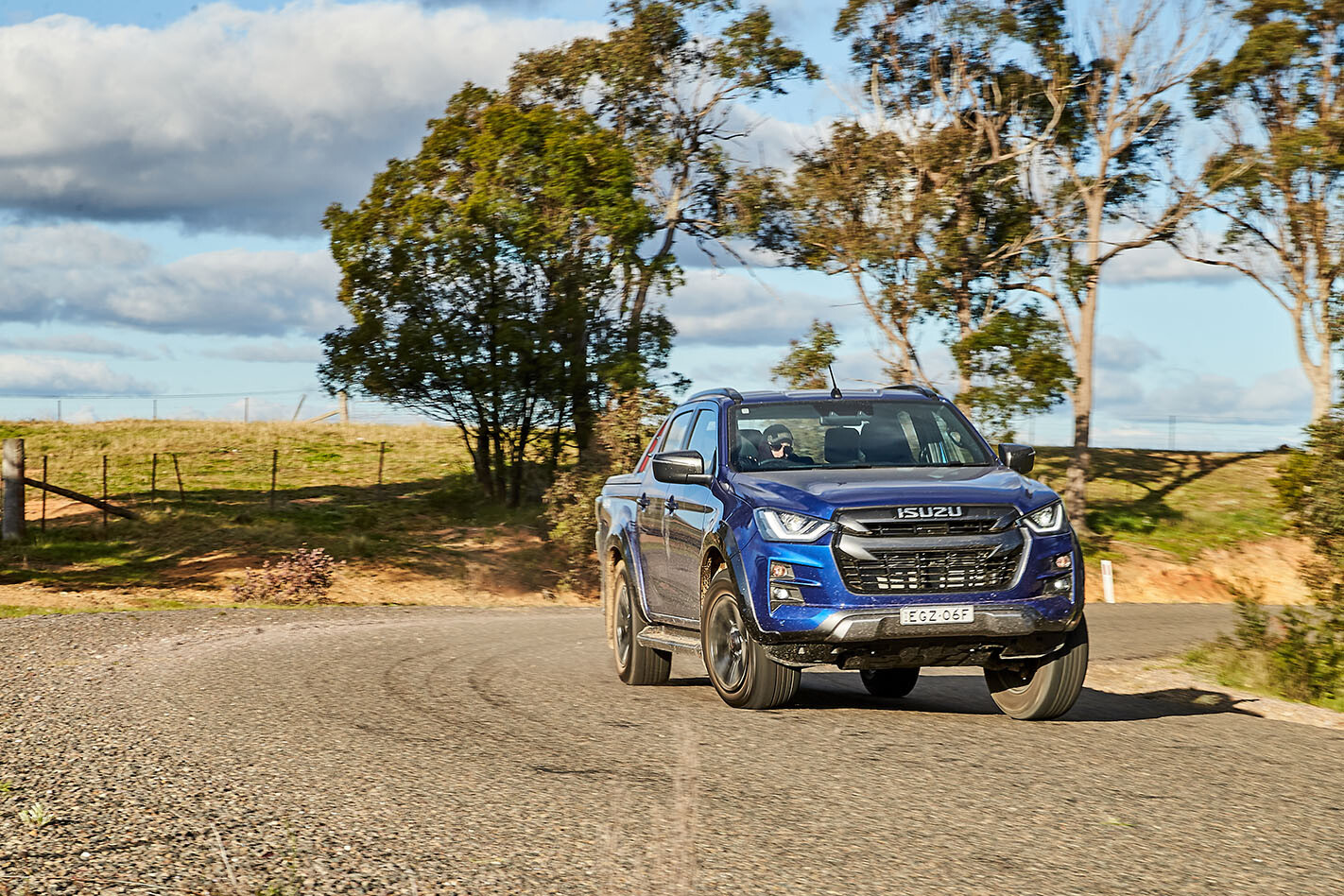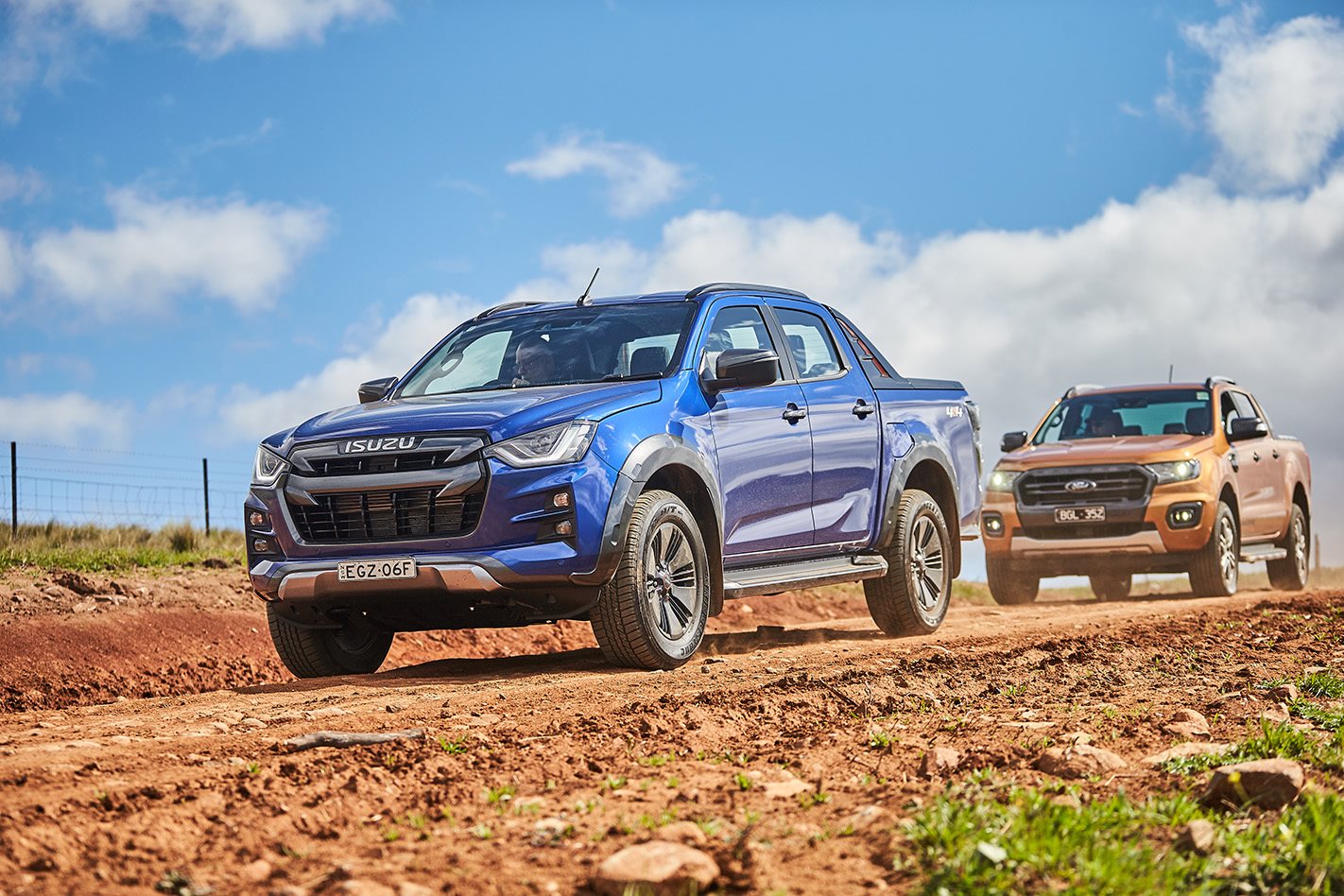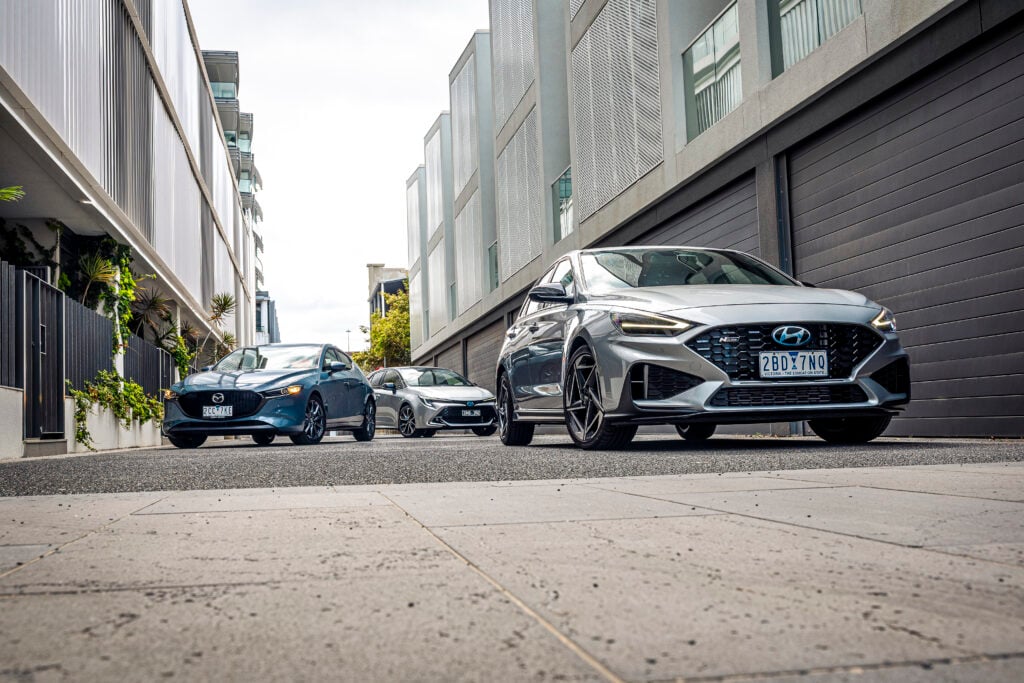The trail is deteriorating as it descends; cracks in the clay base creating fissures wide enough to swallow a wheel, while the rocks have quickly scaled up from softball-sized to bread loaves. Ahead of me, the new Isuzu D-Max picks its path carefully, its shiny flanks now dulling under a first coating of dust.
The trail never gets gnarly enough to require low-range, but flexes just enough attitude to keep SUVs out as it levels off on the valley floor of the Tarlo River National Park in the NSW southern tablelands, and leads us to a causeway across the gentle flow of the river itself.
It occurs to me that if we perhaps had a couple of mountain bikes in the trays and a few kids grubbing up the rear seats of these dual-cabs, we’d actually be using them in the way their makers intended, and realising the buyer aspirations that are obviously fuelling the popularity of this segment. Yes, 4×4 utes are heavily compromised on-road in terms of dynamics, NVH, and pretty much any other metric you want to throw in their direction.
And yes, their leaf-sprung rear ends and drum brakes appear cynical, low-cost throwbacks to a bygone era. But that’s not deterring the tens of thousands of private buyers each year who seem happy to accept this trade-off for the versatility and adventure potential they offer. How many actually use them like this? Doesn’t matter. Knowing they can is what counts.
This demand from private buyers to use their dual-cab utes as family trucksters partly explains why Isuzu has pitched its new D-Max further upmarket than it previously attempted. If you run an eye over our Marketplace page each month, you’ll know that the outgoing D-Max was regularly just outside the top 10 best sellers, trading not on sophistication or a polished driving experience, but more on value, a reputation for rugged reliability, a six-year warranty, affordable servicing schedule, and keen driveaway pricing.
This new model (which Mazda offers repackaged as its new BT-50) aims to retain the nameplate virtues, but moves more upmarket not just in cabin presentation, but significantly, in safety and convenience equipment. Here in top-spec (auto-only) X-Terrain spec it lists for $62,990, a decent chunk above the previous $55K flagship LS-T. Yet you can ignore this number for now, as the X-Terrain is currently being offered at a driveaway deal of $58,990; a figure some pundits suggest will become the regular price.
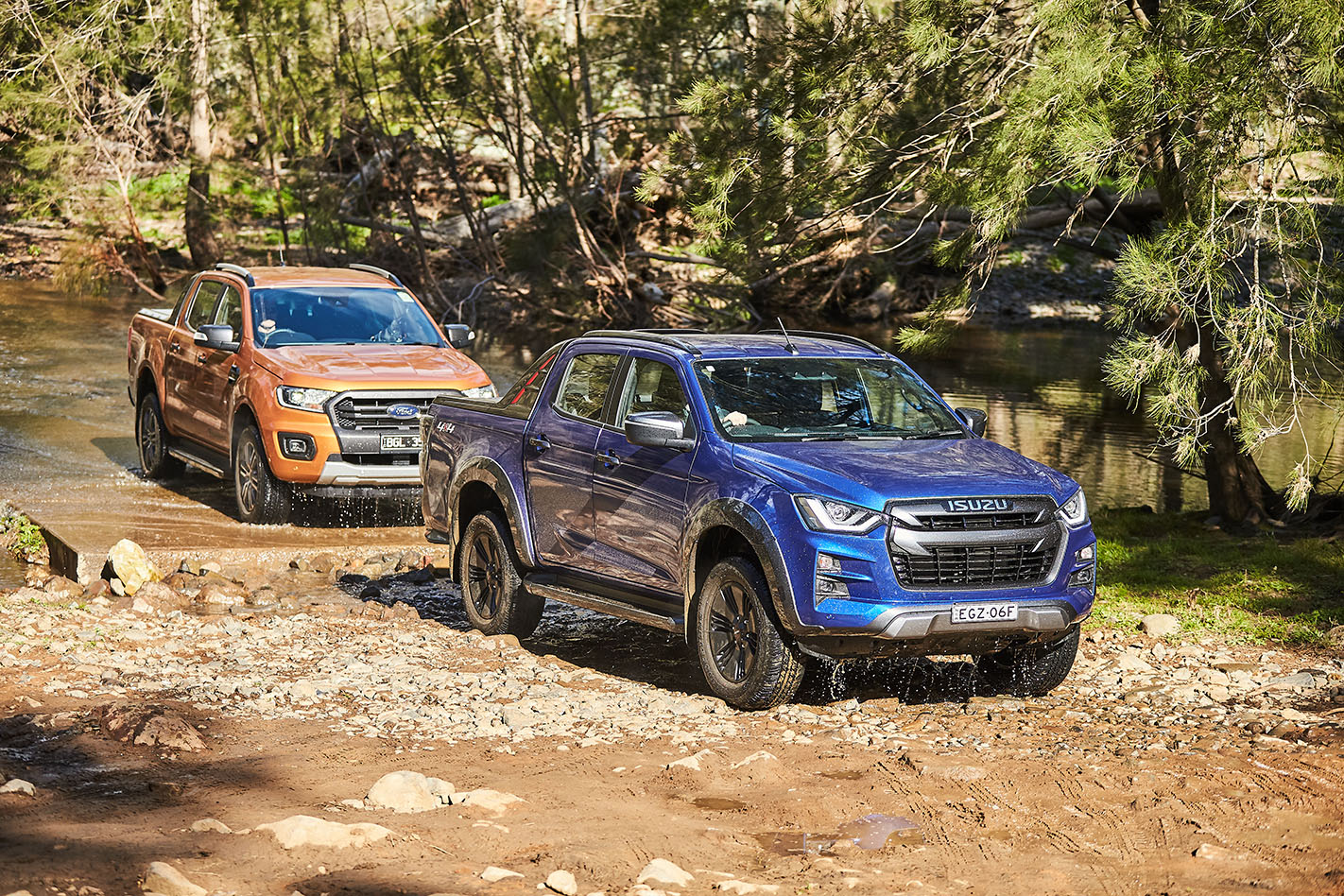
A quick caveat: we originally intended for this to be a three-rig shootout, with the inclusion of the recently updated (and top-selling) Toyota Hilux. Toyota wasn’t able to provide a tester, so we’ve lined up the flagship Isuzu against the other heavyweight in the up-spec ute class, the Ford Ranger Wildtrak, priced at $64,490 driveaway.
If you know your Ford utes, you’ll know that the long-serving in-line 3.2-litre turbo-diesel five-pot is offered right across the four main spec levels, with the more recent 2.0-litre twin-turbo diesel available as an alternative in XLT and Wildtrak, as well as range-topping Raptor.
That’s the engine we’ve gone for here, as it has a refinement advantage over the gravely five-pot, as well as on-paper power and torque superiority, despite the sizeable capacity disadvantage: 157kW/500Nm against the five’s 147kW/470Nm. It also has (count ’em) 10 ratios in its auto transmission; four more than both the transmission fitted to the five-pot, as well as its Isuzu rival here. As it turns out, that’s probably two more than it needs, but we’ll get into that shortly.
As for the engine in the D-Max, the new 4JJ3-TCX is an evolution of the old unit with mostly new bits, rather than a clean-sheet design. (See sidebar, left.) Its peaks of 140kW and 450Nm are gains of 10kW and 20Nm respectively; but still well short of what Ranger delivers with a litre less squeeze space in its four pots.
But clearly this battle is about much more than good old-fashioned grunt. The buying process now involves issues of family safety; suitability for the better half to use the rig for the school run, and keeping the kids happy in the second row. And here the D-Max, by virtue of its newness, grabs an early upper hand. Its dash presentation has an aesthetic that looks a generation ahead of Ranger, because it is.
The instruments, HVAC design and 9.0-inch multimedia screen all look of the moment; whereas the Ford’s smaller 8.0-inch screen and basic HVAC panel look dated by comparison, with the CD slot above confirming that this layout was conceived back when Spotify was to flick mud on the back of your mate’s shirt.
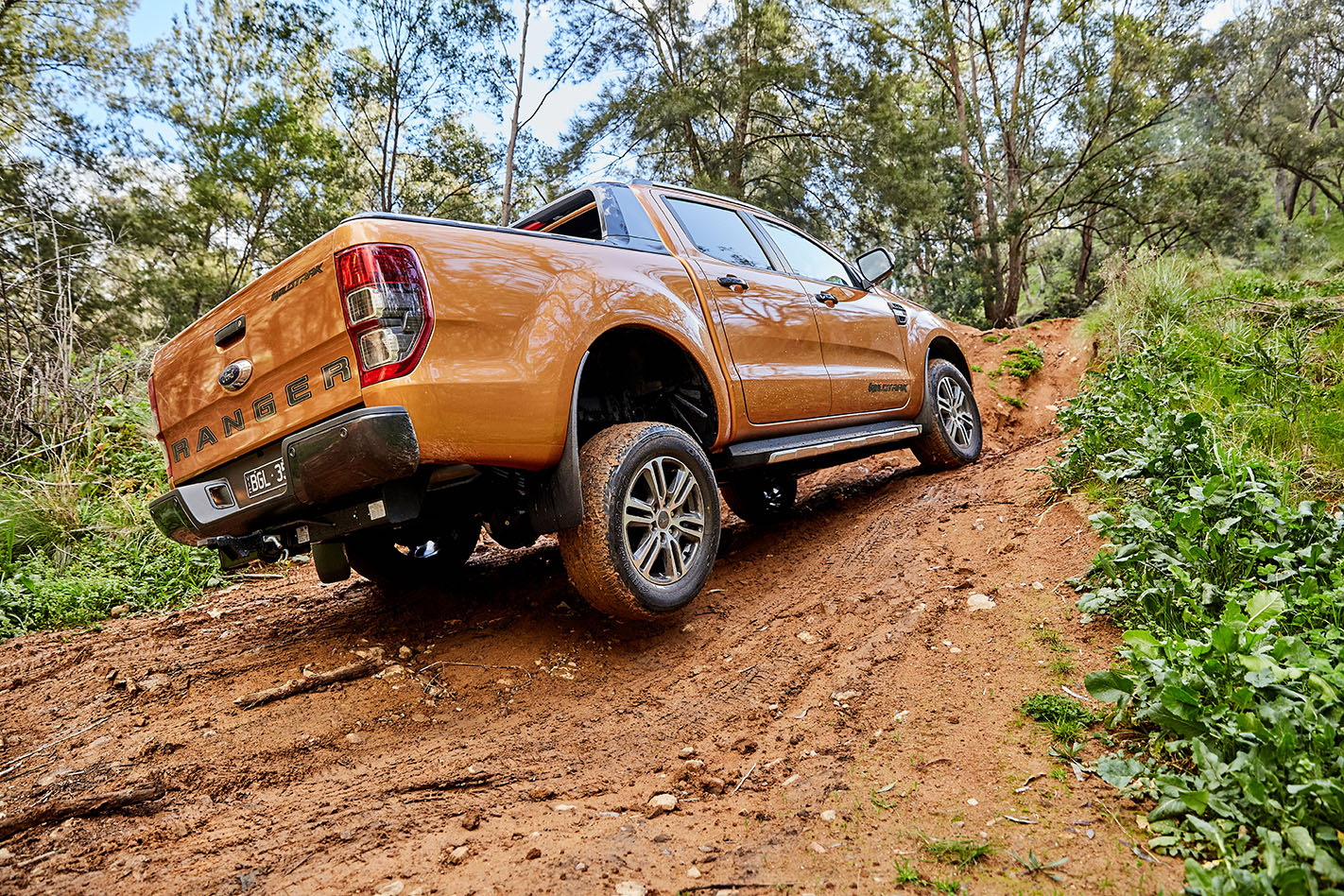
The D-Max’s wheel, too, offers adjustment for both height and reach (the luxury!) compared to the height-only adjustment in the Ranger, making an optimum driving position simple to achieve. And while the Ranger received updates that have helped keep it contemporary – like lane-keep assist and radar cruise – it can’t match the sophistication of the D-Max.
Isuzu’s AEB system, for example, uses twin 3D cameras mounted in the windscreen which enables the tech to more precisely detect vehicles, pedestrians, and cyclists, or tell if you’re about to turn across traffic in front of an oncoming car. Lane-keep assist, blind-spot monitoring and speed-sign recognition (linked to the radar cruise) all feature, and there are now eight airbags, including a first-in-class centre bag between the front occupants. In the Wildtrak, you’ll do without rear cross-traffic alert, blind-spot monitoring, or a 360-degree camera.
But it’s not all a clean-sweep for D-Max. The Ranger’s seats are more shapely, less slippery, and provide a bit more underthigh support than those in the D-Max. The Ford also puts a USB port up in the camera housing ahead of the rear view mirror, allowing you to connect a dash cam without an untidy cable dangling down to the lower console area. And the Isuzu’s up/down buttons for audio volume, instead of a simple knob, seem put there purely to irritate you.
In the back, there’s not much to split them in terms of leg, shoulder and headroom. D-Max provides air vents, a 12v plug, decent-sized door bins and a flip-down armrest with cupholders; all matched by Ranger.
In terms of load ability in the respective trays, not much to split them here although the Ranger handily provides a 12v power outlet in the back, missing from the D-Max. Also, the roller shutter on the Wildtrak can be operated via remote control; the D-Max’s roller shutter is manual, and not as slick in operation. But the wheelarches of both do intrude more than would seem ideal for a load hauler.
If you’re serious about using your dual-cab for agriculture or construction, where you need to have a pallet of materials forklifted straight into the tray, the old but still excellent VW Amarok remains your go-to choice. And if you plan to tow, you’ll find the tow bar standard on Ranger, versus a $1164 option on D-Max.
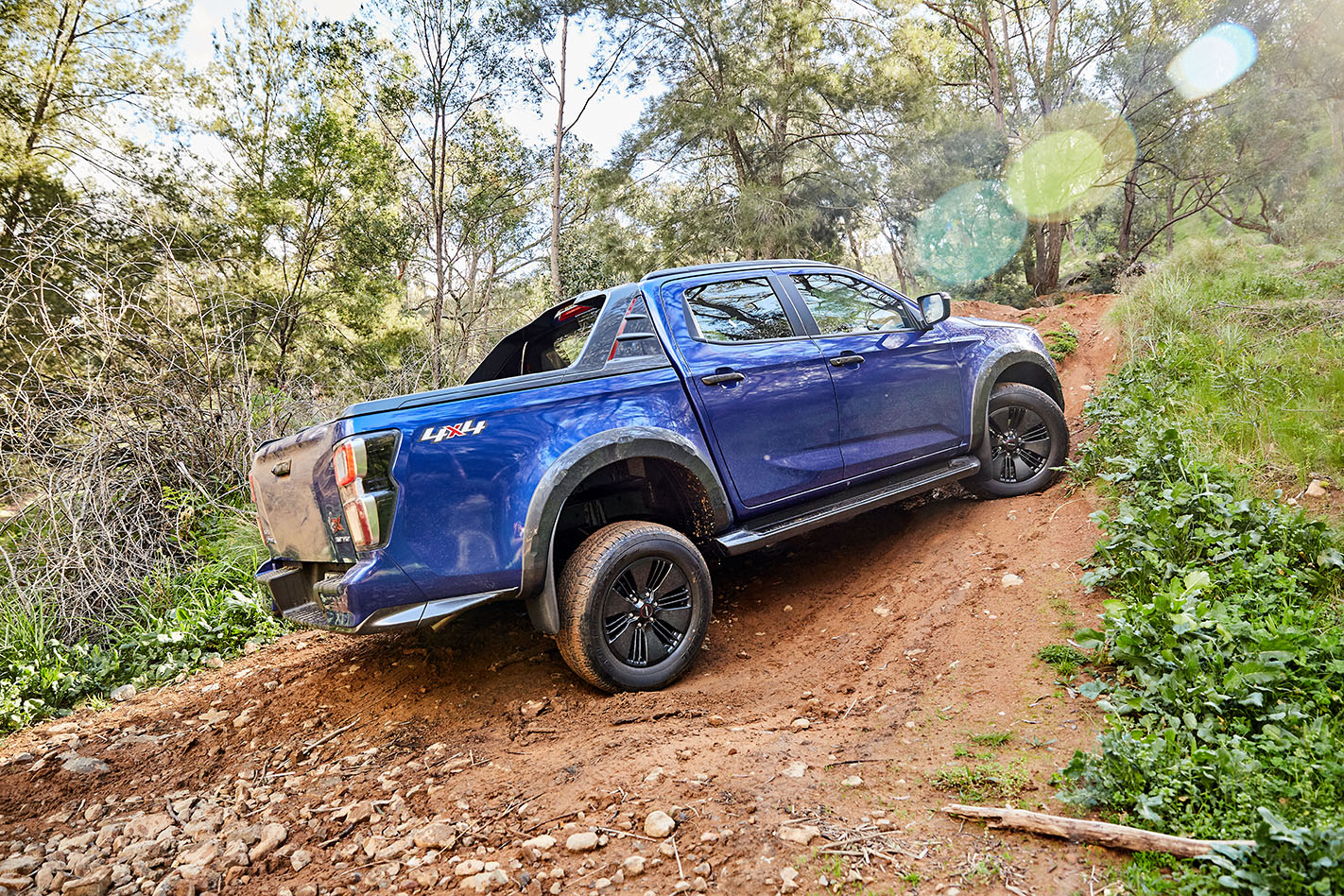
Okay, so despite a few handy counter-jabs, the Wildtrak has to pretty much tap out in submission to the D-Max when it comes to cabin glitz, and gleam of the spec list. But fact is, there’s little wrong with the actual functionality of the Ranger’s cabin, nor its equipment list, and the moment you’re on the move in each of them, well, the sheen of the D-Max suddenly loses a little of the lustre.
Yes, it’s a vast improvement on the old model, but the inescapable fact is the Ranger holds a tangible advantage in just about every aspect of the driving experience. As we claw our way up and out of the Tarlo’s firetrail, it’s a chance to focus on just how much better the Ranger suppresses its diesel soundtrack.
From idle right into the meat of its torque curve, the little 2.0-litre twin-turbo is a way more polished and willing engine, and under load, its auto’s shifts are quick and syrupy smooth. The D-Max is coarser, more vocal and slower to spin up. But thankfully it remains very much a slogger, so really doesn’t need to work hard in normal driving.
Its max torque output of 450Nm is available from 1600rpm to 2600rpm, which is pretty much its optimum operating zone. Check the actual torque curve and we see 400Nm is on tap between 1400rpm and 3250rpm, which is why it mostly feels grunty enough. Toward 4000rpm, though, the louder D-Max sends an audible message that it’s not relishing the workload, and becomes borderline ornery up near max revs.
The more attenuated Ford always sounds industrious and happy to be getting on with the job; there’s less clatter in the step-off phase, a smoother transition into the midrange, and a way more pleasant demeanour when you work it hard. It’s also a little quicker to 100km/h than the D-Max: 9.7sec against 10.2sec for the Isuzu.
As for off-road ability, the new D-Max is now fitted with a locking rear diff (limited to 28km/h in low-range), as well as a more advanced tune for the off-road traction control. The only spot we were able to test both cars was a deeply rutted and greasy climb linking the lower part of the Swallowtail firetrail with the upper section, and both rigs were defeated as their (identical) Bridgestone Duelers spun helplessly in the slime.
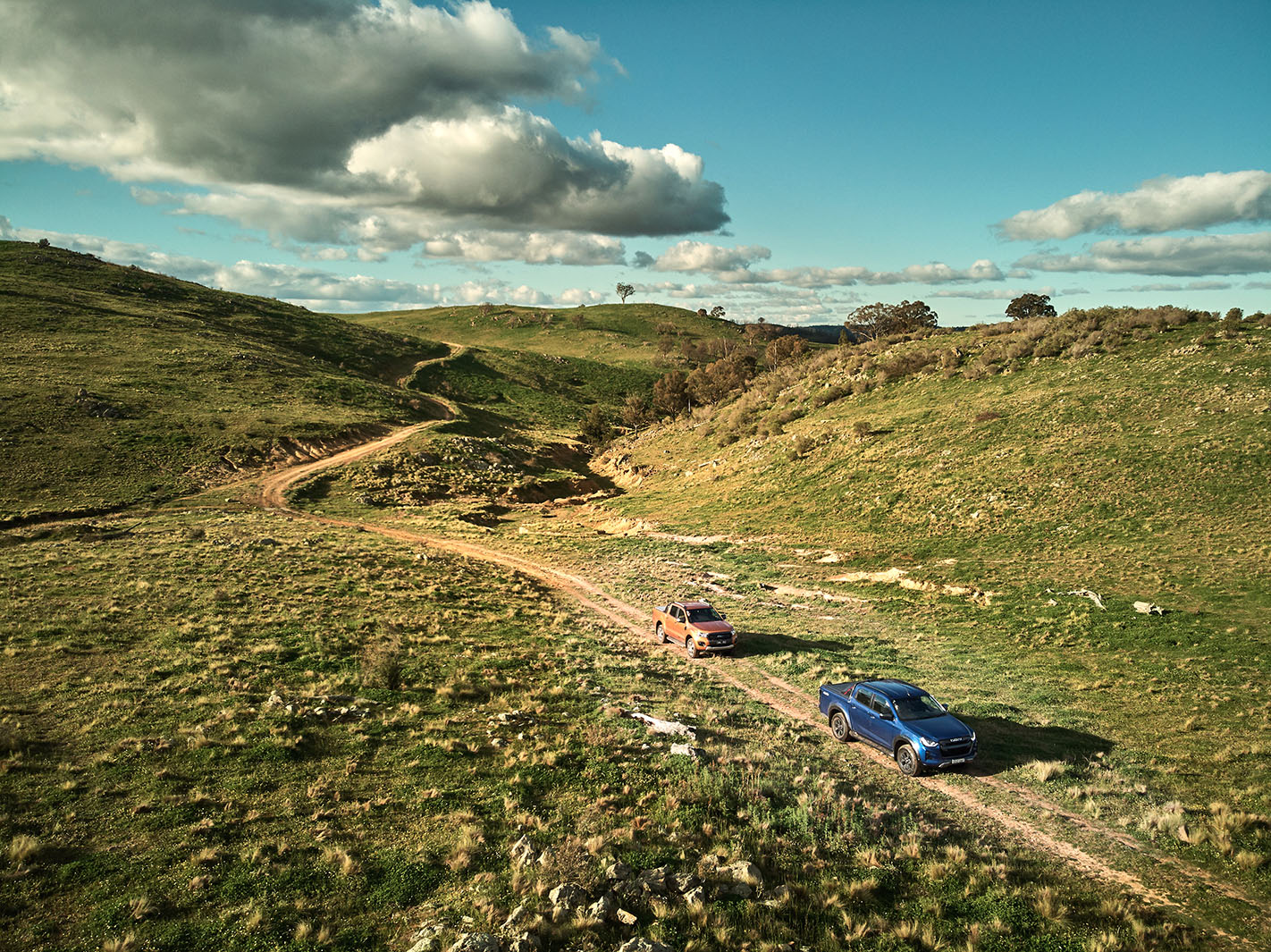
But, improved ground clearance, smaller front and rear overhangs, and decent rear-end articulation do help improve the D-Max off-road. Its wading depth is also improved, now up to 800mm thanks to a redesigned air intake. But it’s worth noting that engaging the D-Max’s rear diff lock also turns off your traction control; not the case in Ranger. Bottom line: both will probably get you through similarly tough terrain; for more extreme work, a change of tyres and suspension lift kit will be needed.
Back on the bitumen, on flowing roads flanking the wind farm near the little town of Taralga, the Ranger takes it powertrain advantage, and doubles down with greater chassis sophistication, despite the advances made by the D-Max.
Isuzu ditched the previously hydraulically assisted steering rack for EPAS (which the Ranger adopted in 2015) so effort is light, and there’s a softness just off centre that makes D-Max feel relaxed at cruising speeds. That’s in contrast to the Ranger, which always feels more hyper-alert. But while the D-Max always provides a faithful sense of connection, it does requires nearly half a turn more from lock to lock, so there’s always greater inputs and arm-twirling needed at roundabouts and in urban cut ’n’ thrust compared to Ranger.
D-Max also features new suspension geometry up front, along with a thicker anti-roll bar, aimed at improving body control, but fact is it’s still no match for the Wildtrak. The Ford holds your chosen line with greater authority, and there’s a compliance in the spring and damper tune that allows the chassis to breathe with Aussie roads.
The Isuzu is stiffer, which delivers admirable body control on the smooth stuff, but makes it more prone to being kicked off line by mid-corner bumps. Shock news just in: Australia has a lot of mid-corner bumps. Over long stints, the D-Max can start to feel as though it’s in a near-constant state of mild agitation with typical B-roads, whereas the Ranger is just loping along, soaking up what’s thrown at it, cheerfully hoovering up the kays.
Granted, in this type of undulating terrain, the Ford’s 10-speed auto can occasionally lose the plot a little, sometimes clunking and hunting excessively for the optimum ratio. More finessing is needed for transmission calibration, and ultimately perhaps an acknowledgement that 10 ratios may be around two too many. But more broadly, the Ranger remains the appreciably better rural tourer.
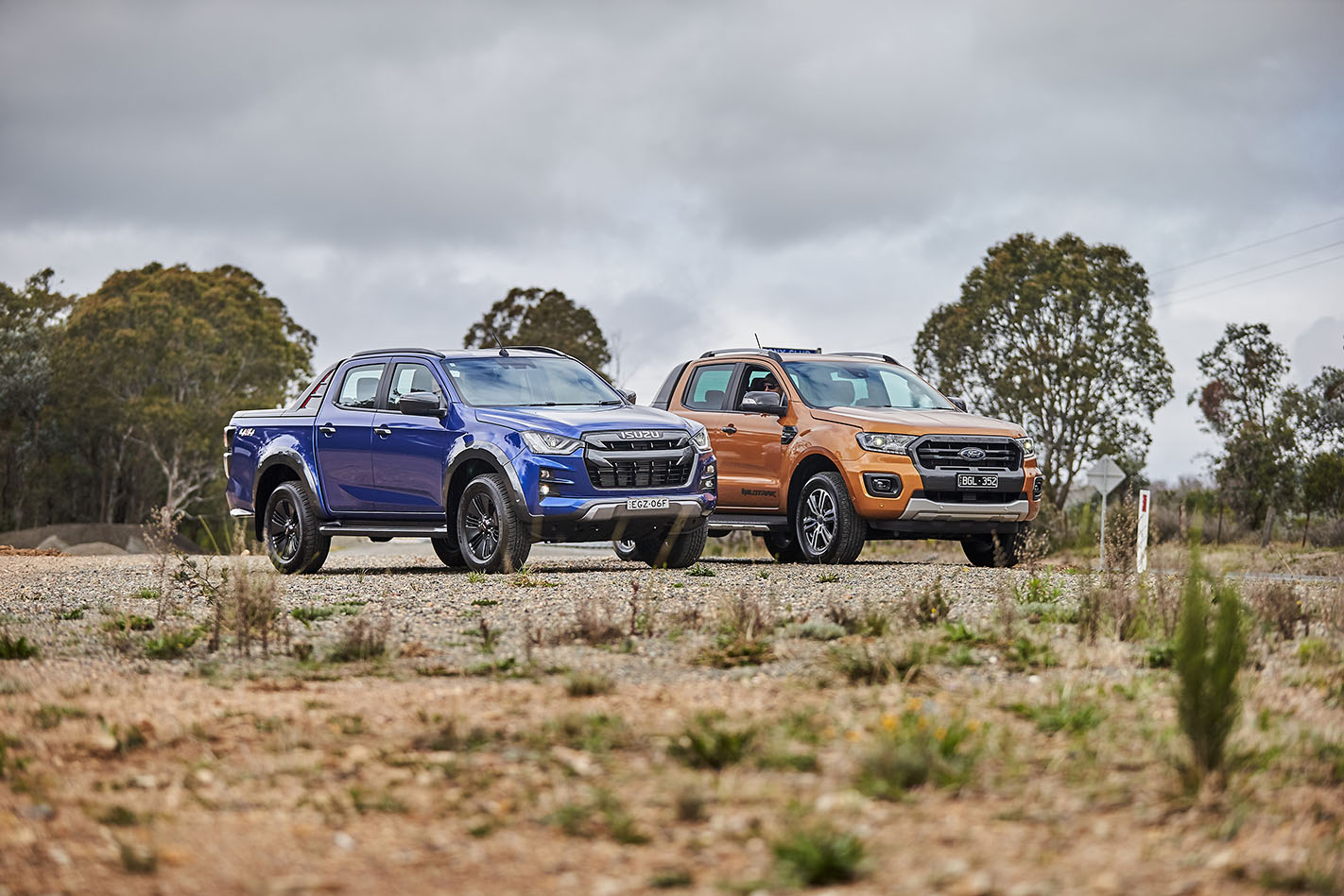
Ultimately, making a call between this pair boils down to where you place a higher priority. The D-Max has leapfrogged to top of this segment for safety, connectivity, driver assistance, and cabin design. The fact it holds a circa-$5500 price advantage over the Ranger Wildtrak is also significant. But the D-Max is also coming off a low base for powertrain refinement and chassis development, and despite the advances, this new model can’t quite overcome those joint hurdles to top the field in these areas.
The Ranger may have been around since 2011, but constant tweaks and upgrades have kept the old stager competitive, and it continues to nail the fundamentals in terms of overall comfort, refinement and drivability. Despite the higher price and lesser spec, we reckon that’s enough to give it a narrow nod here. So, as the sun finally drops below the horizon line, and I start the three-hour haul home towards Sydney’s north, it’s the Wildtrak I want to be in, which says plenty.
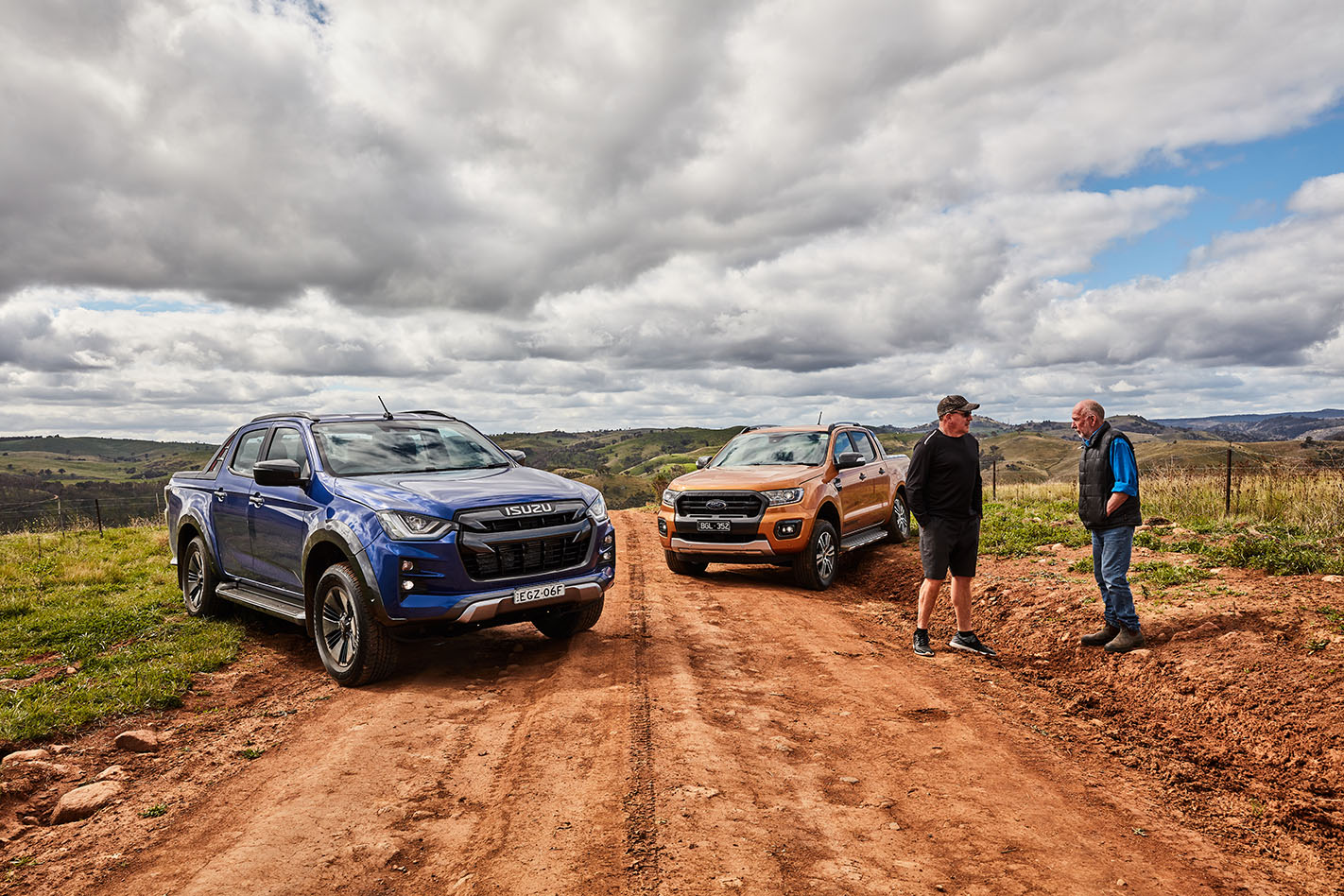
GRIST FOR MILL
Developed specifically for the Australian and Thai markets (the latter where the D-Max is built, and where it outsells Toyota HiLux and Ford Ranger) the Isuzu’s turbo-diesel four still displaces 3.0 litres from the same bore and stroke, but features a new block, head, pistons and fuel-injection system, among other extensive component changes. It’s cleaner, but bumps in both power and torque – 10kW/20Nm – are modest.

THREE THINGS OF NOTE IN THE FORD RANGER
- Ranger shows its age with smaller, lower resolution screen and a slot for those quaint old things called CDs. But good old-fashioned volume knob way superior to D Max’s button-fest.
- There are 10 ratios in Ranger’s auto, and it occasionally gets confused as to which one is optimum for road speed and gradient. In urban driving, though, it’s smooth and quick shifting.
- There’s now an app for Wildtrak called FordPass Connect that will help you locate it if you have a senior moment in a crowded carpark, as well as start it remotely, and provide ‘health alerts’.
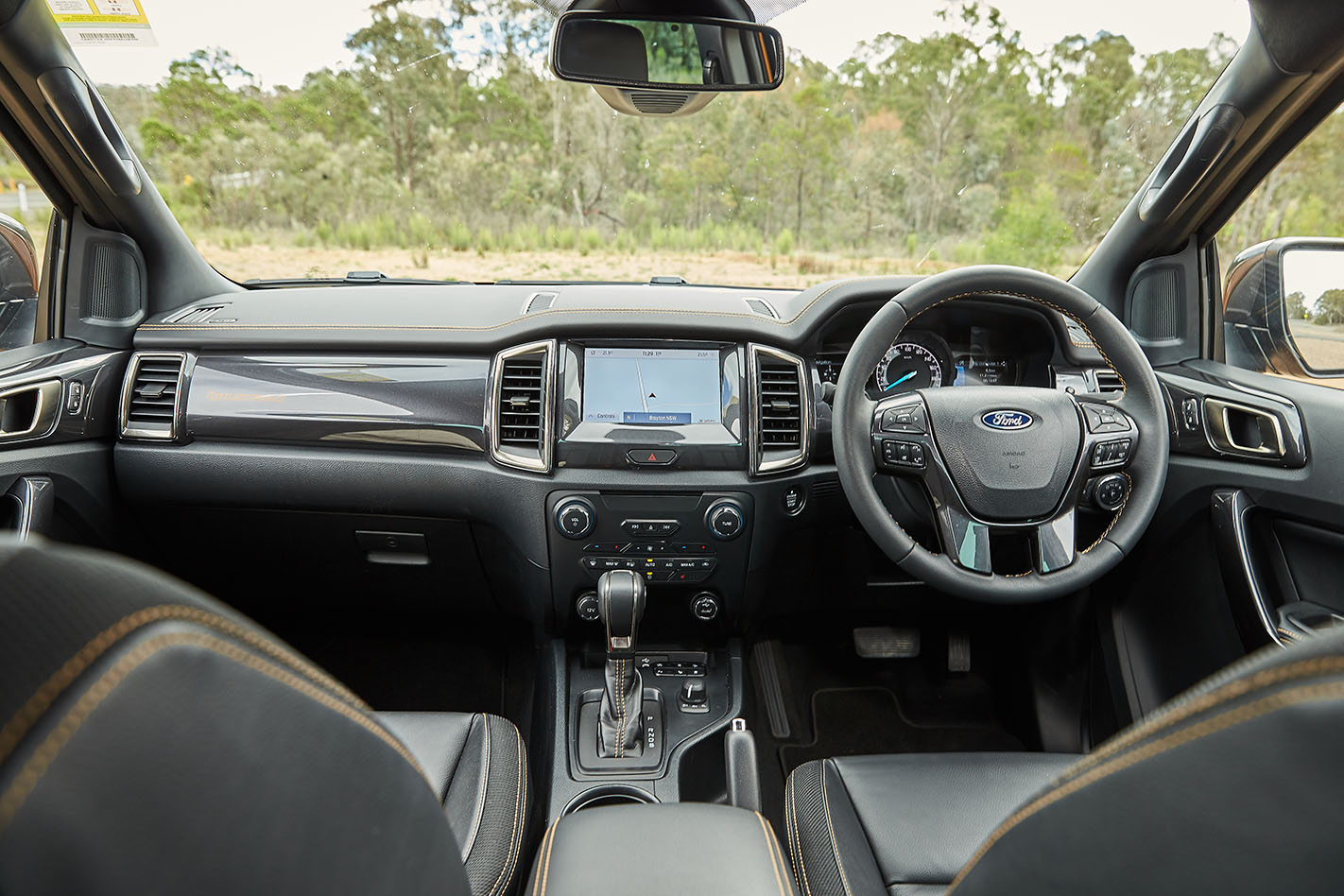
THREE THINGS OF NOTE IN THE ISUZU D-MAX
- D-Max’s larger, hi-res screen wins the multimedia battle, but its sub-menus aren’t always intuitive, and you’ll need to constantly dig around to disable things like lane-keeping.
- Height and reach adjustment for the D-Max’s wheel gives it an advantage over Ranger’s height-only offering. Seats need more under-thigh support, and only driver’s is electric.
- Handy storage options include a lidded compartment in the dash top, separate dual-level gloveboxes, and lidded console bin. Cup holders also swallow an aluminium drink bottle.
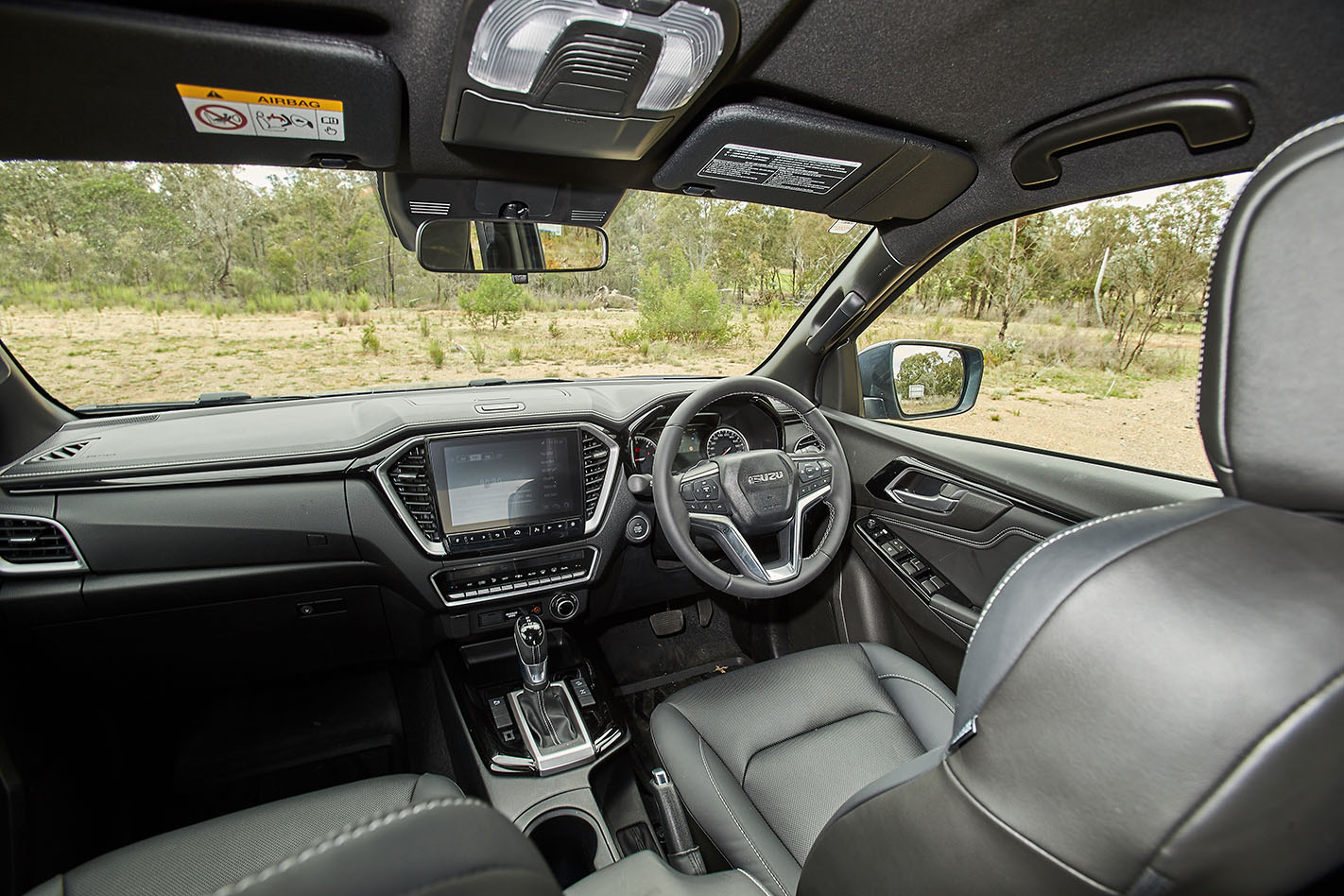
FORD RANGER WILDTRAK SPECS
- Score: 7.5/10
- Price: $64,490 driveaway
- Engine: 4cyl, dohc, 16v, twin-turbo diesel
- Layout: front engine (north-south), all drive
- Capacity: 1996cc
- Power: 157kW @ 3750rpm
- Torque: 500Nm @ 1750-2000rpm
- Gearbox: 10-speed automatic
- Body: steel, 4 doors, 5 seats
- L/W/H/W–B: 5389/1850/1848/3220mm
- Track (F/R): 1560/1569mm
- Weight: 2200kg
- Payload: 1136kg
- Fuel/tank: diesel/80 litres
- Economy: 11.5L/100km (test average)
- Front suspension: struts, A-arms, coil springs, anti-roll bar
- Rear suspension: leaf springs, dampers, anti-roll bar
- Steering: electric rack-and-pinion
- Turn circle: 12.7m (3.2 turns lock-to-lock)
- Front brakes: ventilated discs (310mm)
- Rear brakes: drums (295mm)
- Tyres: Bridgestone Dueler HT
- Tyre size: 265/60 R18
- ANCAP rating: 5 stars
- Warranty: 5yr/unlimited km.
- Service interval: 12 months/15,000km.
- Glass’s 3-year resale: 54%
- Budget Direct insurance: $1130.

ISUZU D-MAX X-TERRAIN SPECS
- Score: 7.0/10
- Price: $58,990 driveaway
- Engine: 4cyl, dohc, 16v, turbo diesel
- Layout: front engine (north-south), all drive
- Capacity: 2999cc
- Power: 140kW @ 3600rpm
- Torque: 450Nm @ 1600-2600rpm
- Gearbox: 6-speed automatic
- Body: steel, 4 doors, 5 seats
- L/W/H/W-B: 5280/1880/1810/3125mm
- Track (F/R): 1570/1570mm
- Weight: 2130kg
- Payload: 970kg
- Fuel/tank: diesel/76 litres
- Economy: 11.2L/100km (test average)
- Front suspension: struts, A-arms, coil springs, anti-roll bar
- Rear suspension: leaf springs, dampers, anti-roll bar
- Steering: electric rack-and-pinion
- Turn circle: 12.5m (3.8 turns lock-to-lock)
- Front brakes: ventilated discs (320mm)
- Rear brakes: drums (295mm)
- Tyres: Bridgestone Dueler HT
- Tyre size: 265/60 R18
- ANCAP rating: 5 stars
- Warranty: 6yr/unlimited km.
- Service interval: 12 months/15,000km.
- Glass’s 3-year resale: 55%.
- AAMI Insurance: $1224.
